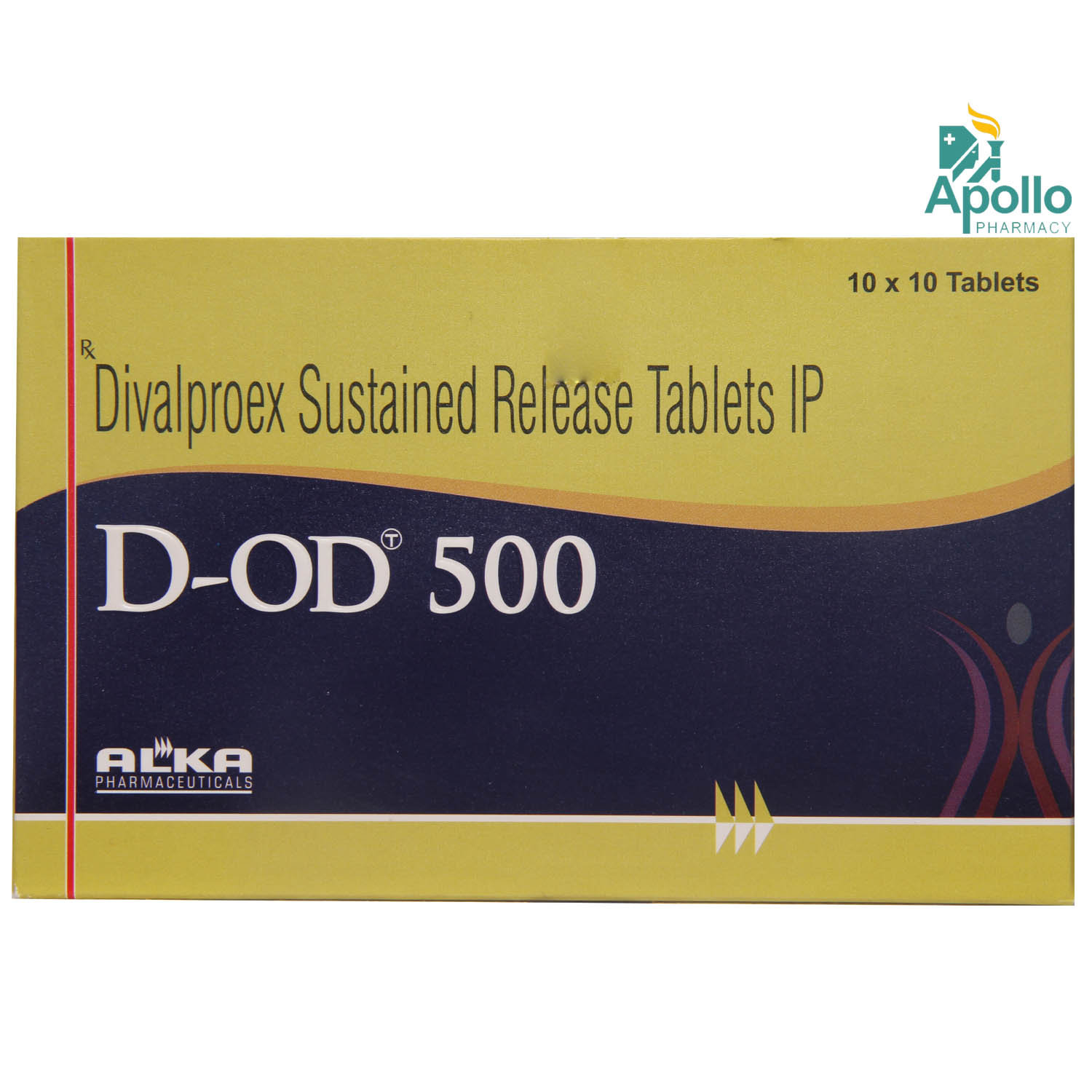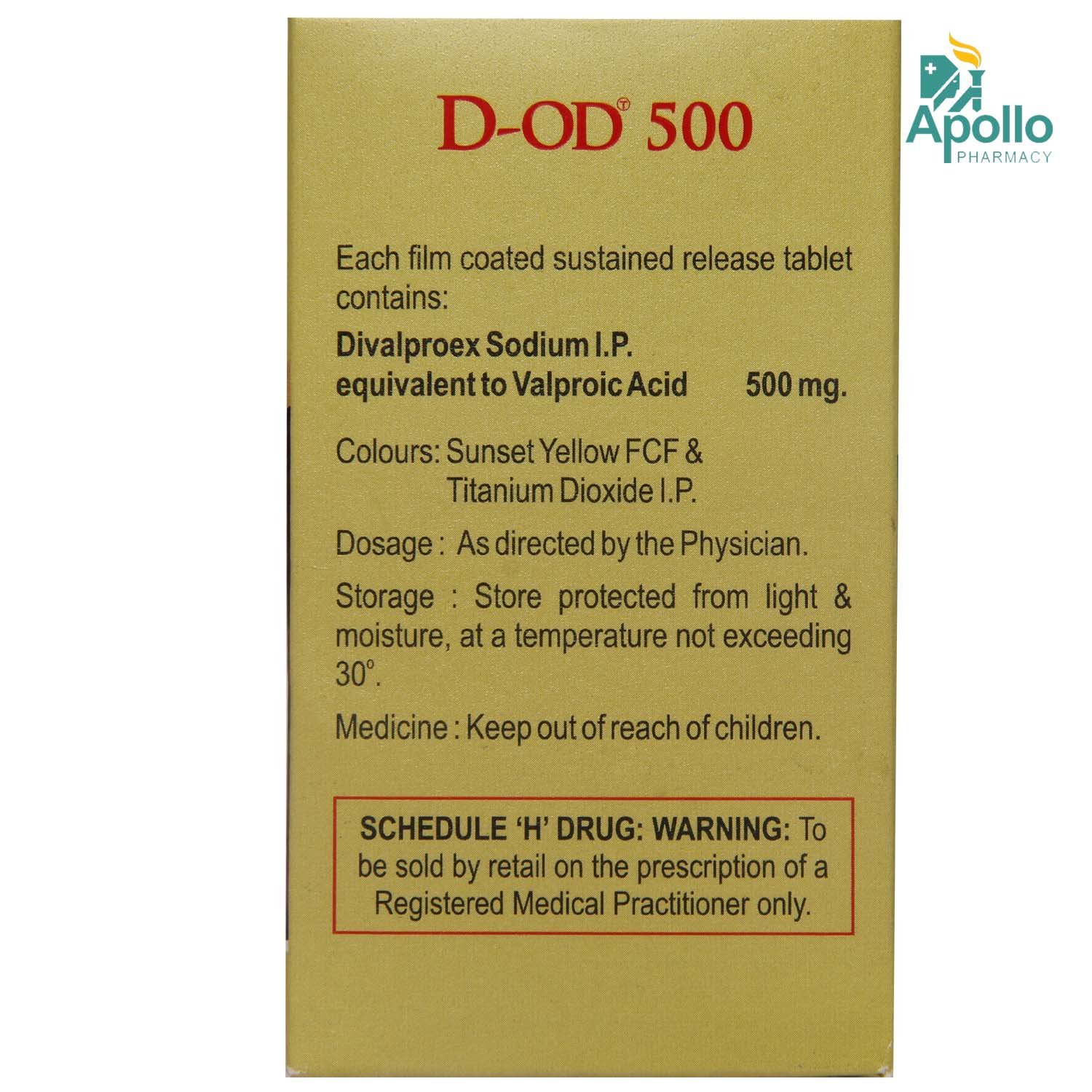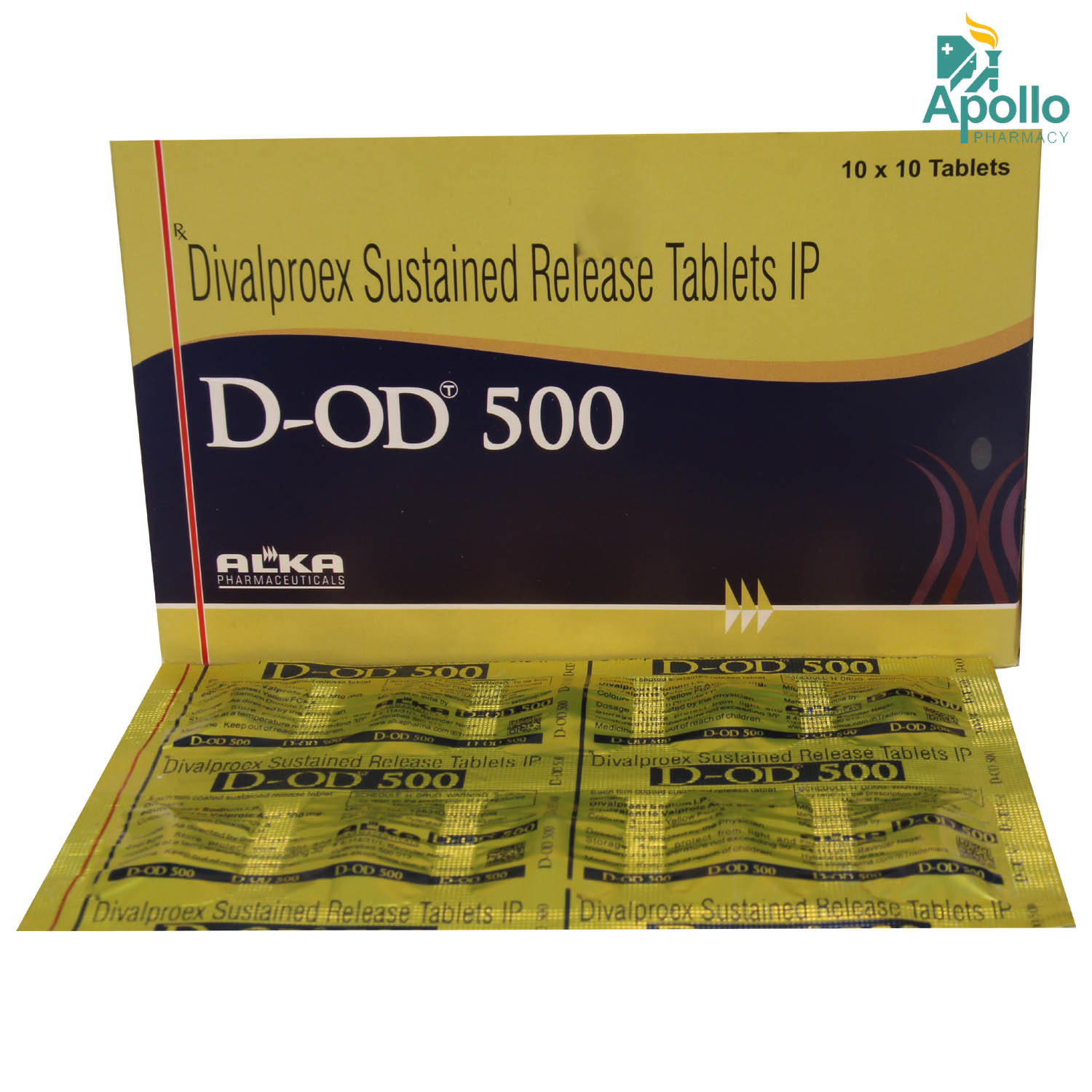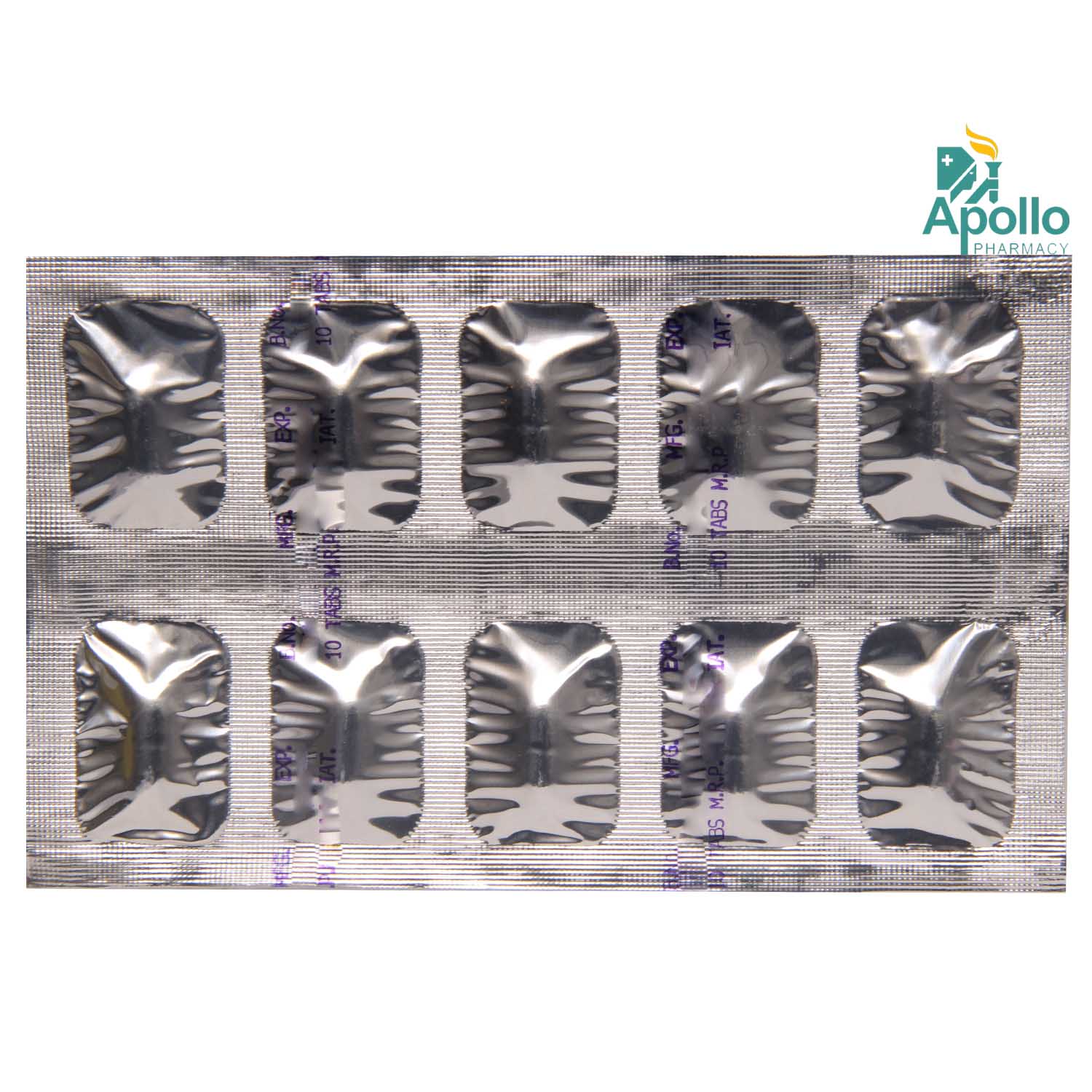D OD 500 TABLET 1





MRP ₹112.5
(Inclusive of all Taxes)
₹16.9 Cashback (15%)
know your delivery time
Provide Delivery Location
Composition :
Manufacturer/Marketer :
Consume Type :
Expires on or after :
Return Policy :

Secure Payment

Trusted by 8 Crore Indians

Genuine Products
Therapeutic Class
Country of origin
Manufacturer/Marketer address
Author Details
We provide you with authentic, trustworthy and relevant information
Disclaimer
Alcohol
Safe if prescribed
Do not consume alcohol while taking D OD 500 TABLET 1 as alcohol can worsen the side effects of the D OD 500 TABLET 1, including sleepiness and dizziness.
Pregnancy
Consult your doctor
D OD 500 TABLET 1 is a Category D pregnancy drug. It is not recommended for use during pregnancy as it may cause an increase in the risk of a cleft lip, which is a congenital disability in the unborn baby. If you are a female able to have a baby, you must use an effective method of birth control (contraception) without interruption during your entire treatment with D OD 500 TABLET 1.
Breast Feeding
Consult your doctor
D OD 500 TABLET 1 passes into breast milk and may harm your infant. Please consult a doctor if you are breastfeeding before taking D OD 500 TABLET 1. Breastfed infants are at risk for valproic acid-induced hepatotoxicity, so infants should be monitored for jaundice and other signs of liver damage during maternal therapy.
Driving
Safe if prescribed
D OD 500 TABLET 1 may cause dizziness, drowsiness or tiredness in some people. Therefore, avoid driving if you feel drowsy, dizzy or tired after taking D OD 500 TABLET 1.
Liver
Consult your doctor
Inform your doctor before receiving the D OD 500 TABLET 1 if you have a history of liver diseases/conditions. Extreme caution is recommended in patients with impaired liver function. Your doctor will weigh the benefits and potential risks before prescribing D OD 500 TABLET 1.
Kidney
Consult your doctor
Dose adjustment may be needed in patients with kidney impairment. Please inform your doctor if you have kidney impairment.
Children
Safe if prescribed
Use is not recommended for children less than ten years. Your doctor will decide the dose based on your child's condition if more than ten years.
About D OD 500 TABLET 1
D OD 500 TABLET 1 belongs to a group of anticonvulsants or anti-epileptics used to treat epilepsy/seizures/fits. In addition, D OD 500 TABLET 1 also treats manic episodes associated with bipolar disorder. Besides this, it can also prevent migraine symptoms (like a headache). Epilepsy is a sudden rush of electricity in the brain. In epilepsy, the brain's electrical rhythms become imbalanced, resulting in recurrent seizures, sometimes leading to an unconscious state.
D OD 500 TABLET 1 contains Valproic acid, which reduces the brain's excessive and aberrant nerve activity. As a result, it aids in the control of seizures. D OD 500 TABLET 1 raises the concentration of a chemical molecule known as GABA, which helps to stop nerve communication across the brain and has a calming effect. This contributes to the treatment of bipolar disorder. D OD 500 TABLET 1 limits the transmission of nerve pain, thereby preventing migraine headaches.
D OD 500 TABLET 1 should be taken as prescribed by the doctor. You may sometimes experience nausea, upset stomach or stomach pain, tremors (shakes), sleepiness, headache, weight gain and thinning hair. Most of these side effects are temporary and will go away on their own. However, if you suffer these adverse effects on a regular basis, you should consult your doctor.
Inform your doctor if you are allergic to any components present in D OD 500 TABLET 1. If you are pregnant, do not take D OD 500 TABLET 1 because it may cause serious congenital defects. Use effective contraception if you are of childbearing age while taking D OD 500 TABLET 1. If you are breastfeeding, inform your doctor before taking D OD 500 TABLET 1. As D OD 500 TABLET 1 causes sleepiness and dizziness, do not drive or operate machinery. Avoid drinking alcohol with D OD 500 TABLET 1 as it may cause dizziness and tiredness. To rule out any negative effects, keep your doctor updated about your health condition and medications.
Uses of D OD 500 TABLET 1
Medicinal Benefits Mweb
Key Benefits
D OD 500 TABLET 1 contains Valproic acid, an anticonvulsant (or anti-epileptic) medicine that reduces the brain's excessive and aberrant nerve activity. As a result, it aids in the control of seizures. D OD 500 TABLET 1 raises the concentration of a chemical molecule known as GABA, which helps to stop nerve communication across the brain and has a calming effect. This contributes to the treatment of bipolar disorder. D OD 500 TABLET 1 limits the transmission of nerve pain, thereby preventing migraine headaches.
Directions for Use
Side Effects of D OD 500 TABLET 1
- Stomach pain
- Feeling or being sick
- Diarrhoea
- Dry or sore mouth or swollen gums
- Shakes (tremors) in a part of your body
- Unusual eye movements
- Feeling tired or sleepy
- Headache
- Weight gain
- Thinning hair, or changes to the colour or texture of your hair
- Irregular or delayed periods
Drug Warnings
Before taking the D OD 500 TABLET 1, let your doctor know about all your medical conditions, sensitivities, and all medications you are using. And also, inform your doctor if you are pregnant, suspect you are pregnant, plan to have a baby, or are breastfeeding. You should not become pregnant while you are receiving D OD 500 TABLET 1. Consult your doctor immediately if you become pregnant while receiving a D OD 500 TABLET 1. Alcohol should be avoided during treatment with this medicine. You must not drive or operate machinery while receiving D OD 500 TABLET 1.
Drug-Drug Interactions
Drug-Drug Interactions
Login/Sign Up
Combining Sodium phenylbutyrate and D Od 500 Tablet 10's can increase ammonia levels in the blood.
How to manage the interaction:
Taking Sodium phenylbutyrate with D Od 500 Tablet 10's is not recommended, but it can be taken if prescribed by a doctor. If you experience any symptoms like sudden dizziness, lightheadedness, fainting, headache, shortness of breath, nausea, vomiting, chest pain or tightness, rapid heartbeat, or memory loss, contact your doctor immediately. Do not discontinue any medications without consulting a doctor.
Co-administration of Teriflunomide and D Od 500 Tablet 10's can increase the risk of causing liver problems.
How to manage the interaction:
Co-administration of Teriflunomide and D Od 500 Tablet 10's can lead to an interaction, it can be taken if advised by your doctor. However, if you experience any symptoms like fever, chills, joint pain or swelling, unusual bleeding or bruising, skin rash, itching, loss of appetite, fatigue, nausea, vomiting, abdominal pain, dark-colored urine, light-colored stools, and yellowing of the skin or eyes. Avoid alcohol while taking these medications, and consult your doctor immediately. Do not discontinue any medications without consulting your doctor.
Co-administration of Lithium with D Od 500 Tablet 10's can increase the risk irregular heart rhythm.
How to manage the interaction:
Co-administration of Lithium and D Od 500 Tablet 10's can lead to an interaction, but it can be taken if advised by your doctor. However, consult your doctor immediately if you experience any symptoms like dizziness, drowsiness, confusion, lightheadedness, fainting, shortness of breath, chest pain or tightness, rapid heartbeat, and difficulty concentrating. Do not discontinue any medications without consulting a doctor.
Co-administration of D Od 500 Tablet 10's with doripenem can reduce the blood levels of valproic acid.
How to manage the interaction:
Co-administration of Doripenam and D Od 500 Tablet 10's can lead to an interaction, it can be taken if advised by your doctor. However, if you experience sudden dizziness, lightheadedness, fainting, shortness of breath, chest pain or tightness, rapid heartbeat, involuntary muscle movements, or memory loss, contact your doctor immediately. Do not discontinue any medications without consulting a doctor.
Co-administration of Leflunomide and D Od 500 Tablet 10's can increase the risk of causing liver problems.
How to manage the interaction:
Co-administration of Leflunomide and D Od 500 Tablet 10's can lead to an interaction, they can be taken together if prescribed by a doctor. However, if you experience fever, chills, joint pain or swelling, unusual bleeding or bruising, skin rash, itching, less desire to eat, fatigue, nausea, vomiting, abdominal pain, or yellowing of the skin or eyes, contact a doctor immediately. Do not discontinue any medications without consulting a doctor.
The combined use of Ertapenem and D Od 500 Tablet 10's can reduce the blood levels of valproic acid.
How to manage the interaction:
Co-administration of Ertapenem and D Od 500 Tablet 10's can lead to an interaction, it can be taken if advised by your doctor. However, if you experience any symptoms like loss of seizure control or changes in behavior, consult your doctor immediately. Do not discontinue any medications without consulting the doctor.
Co-administration of Ketamine and D Od 500 Tablet 10's can increase side effects and cause respiratory depression.
How to manage the interaction:
Co-administration of Ketamine and D Od 500 Tablet 10's can lead to an interaction, but it can be taken if your doctor advises. However, consult your doctor immediately if you experience any symptoms like dizziness, drowsiness, confusion, difficulty concentrating, excessive sedation, impaired thinking, judgment, and motor coordination. Avoid driving or operating hazardous machinery until you know how these medications affect you. Do not discontinue any medications without consulting the doctor.
Co-administration of Meropenam and D Od 500 Tablet 10's together can reduce the effect of D Od 500 Tablet 10's.
How to manage the interaction:
Co-administration of Meropenam and D Od 500 Tablet 10's can lead to an interaction, but it can be taken if your doctor advises. However, if you experience any unusual symptoms, consult a doctor immediately. Do not discontinue any medications without consulting a doctor.
Co-administration of Vorinostat with D Od 500 Tablet 10's can increase the risk of unusual bleeding.
How to manage the interaction:
Co-administration of Vorinostat and D Od 500 Tablet 10's can lead to an interaction, it can be taken if advised by your doctor. However, if you experience any symptoms like unusual bleeding or bruising, vomiting, blood in your urine or stools, headache, dizziness, or weakness, consult your doctor immediately. Do not discontinue any medications without consulting your doctor.
Using buprenorphine together with D Od 500 Tablet 10's may increase the risk of severe side effects, including respiratory problems and loss of consciousness.
How to manage the interaction:
Although the administration of buprenorphine alongside D Od 500 Tablet 10's can result in an interaction, it can be taken if a doctor has advised it. However, if you experience sudden dizziness, lightheadedness, fainting, shortness of breath, chest pain or tightness, rapid heartbeat, or memory loss, contact a doctor immediately. Do not discontinue any medications without consulting a doctor.
Drug-Food Interactions
Drug-Food Interactions
Login/Sign Up
Drug-Diseases Interactions
Drug-Diseases Interactions
Login/Sign Up
Drug-Drug Interactions Checker List
- CARBAMAZEPINE
- WARFARIN
- ASPIRIN
- CIMETIDINE
- RITONAVIR
- ERYTHROMYCIN
- VENLAFAXINE
- QUETIAPINE
- CHOLESTYRAMINE
- MEFLOQUINE
- CHLOROQUINE
Habit Forming
Special Advise
- Blood and urine tests may be affected by the D OD 500 TABLET 1. Inform the person conducting the exams that you will be taking D OD 500 TABLET 1.
- If you are of childbearing age, utilise effective contraception continuously during your treatment with D OD 500 TABLET 1.
- Contact your doctor immediately if you become pregnant while taking D OD 500 TABLET 1.
Diet & Lifestyle Advise
- Adolescents and adults are advised to follow the Atkins diet (high fat, low carbohydrate).
- Exercising on a regular basis aids with weight maintenance and general health.
- Rest well, and get plenty of sleep.
- Avoid smoking and drinking alcohol.
- Meditation and yoga can help reduce stress, reduce pain sensitivity, and increase coping abilities.
- Have a seizure response plan in place, and make sure everyone around you knows what to do in the event of a seizure.
- Prepare your living environment; simple changes may help reduce the risk of physical damage during a seizure.
- Understand what causes seizures and try to reduce or avoid them.
- Please keep your overall health in mind, as it can aid in the reduction of seizure activity.
- Install an alarm or an emergency gadget to summon help during a seizure attack.

Have a query?
Buy best C.n.s Drugs products by
Intas Pharmaceuticals Ltd
Sun Pharmaceutical Industries Ltd
Torrent Pharmaceuticals Ltd
Alkem Laboratories Ltd
Abbott India Ltd
Cipla Ltd
Alteus Biogenics Pvt Ltd
Micro Labs Ltd
Lupin Ltd
Ipca Laboratories Ltd
D D Pharmaceuticals Pvt Ltd
Icon Life Sciences
Mankind Pharma Pvt Ltd
Tripada Healthcare Pvt Ltd
Arinna Lifesciences Ltd
Linux Laboratories Pvt Ltd
East West Pharma India Pvt Ltd
La Renon Healthcare Pvt Ltd
Talent India Pvt Ltd
Tas Med India Pvt Ltd
Zydus Healthcare Ltd
Cnx Health Care Pvt Ltd
Eris Life Sciences Ltd
Leeford Healthcare Ltd
Emcure Pharmaceuticals Ltd
Macleods Pharmaceuticals Ltd
Sigmund Promedica
Aristo Pharmaceuticals Pvt Ltd
Dr Reddy's Laboratories Ltd
Troikaa Pharmaceuticals Ltd
Consern Pharma Ltd
Zydus Cadila
Shine Pharmaceuticals Ltd
Wockhardt Ltd
Ardent Life Sciences Pvt Ltd
Crescent Formulations Pvt Ltd
Theo Pharma Pvt Ltd
Reliance Formulation Pvt Ltd
Ikon Pharmaceuticals Pvt Ltd
Propel Healthcare
Neon Laboratories Ltd
Jagsam Pharma
Msn Laboratories Pvt Ltd
Morepen Laboratories Ltd
Pulse Pharmaceuticals
Sanofi India Ltd
Med Manor Organics Pvt Ltd
Hetero Healthcare Pvt Ltd
Novartis India Ltd
Crescent Therapeutics Ltd
Elder Pharmaceuticals Ltd
Solvate Laboratories Pvt Ltd
Akumentis Healthcare Ltd
Mova Pharmaceutical Pvt Ltd
Psyco Remedies Ltd
Tripada Lifecare Pvt Ltd
Ajanta Pharma Ltd
Cyrus Remedies Pvt Ltd
Medishri Healthcare Pvt Ltd
Cadila Healthcare Ltd
Glenmark Pharmaceuticals Ltd
Matteo Health Care Pvt Ltd
Hbc Life Sciences Pvt Ltd
Lyf Healthcare
Matias Healthcare Pvt Ltd
Mesmer Pharmaceuticals
Alembic Pharmaceuticals Ltd
Capital Pharma
Crescent Pharmaceuticals
Medopharm Pvt Ltd
Alniche Life Sciences Pvt Ltd
Kivi Labs Ltd
Talin Remedies Pvt Ltd
USV Pvt Ltd
Quince Lifesciences Pvt Ltd
Solis Pharmaceuticals
Infivis Life Care
Zuventus Healthcare Ltd
Cadila Pharmaceuticals Ltd
Pfizer Ltd
Wallace Pharmaceuticals Pvt Ltd
A N Pharmacia Laboratories Pvt Ltd
Blue Cross Laboratories Pvt Ltd
Jenburkt Pharmaceuticals Ltd
Lia Life Sciences Pvt Ltd
Mano Pharma
Medley Pharmaceuticals Ltd
Primus Remedies Pvt Ltd
FDC Ltd
Maneesh Pharmaceuticals Ltd
Apex Laboratories Pvt Ltd
Gagnant Healthcare Pvt Ltd
Ozone Pharmaceuticals Ltd
RPG Life Sciences Ltd
Strides Shasun Ltd
Unichem International
GlaxoSmithKline Pharmaceuticals Ltd
Kuresys Labs Pvt Ltd
LA Pharma
Trion Pharma India Llp
Recommended for a 30-day course: 3 Strips


